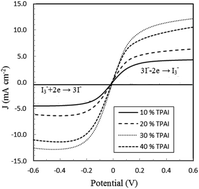Electrocatalytic and structural properties and computational calculation of PAN-EC-PC-TPAI-I2 gel polymer electrolytes for dye sensitized solar cell application
Abstract
In this study, gel polymer electrolytes (GPEs) were prepared using polyacrylonitrile (PAN) polymer, ethylene carbonate (EC), propylene carbonate (PC) plasticizers and different compositions of tetrapropylammonium iodide (TPAI) salt. Linear sweep voltammetry (LSV) and electrochemical impedance spectroscopy (EIS) measurements were done using non-blocking Pt-electrode symmetric cells. The limiting current (Jlim), apparent diffusion coefficient of triiodide ions  and exchange current were found to be 12.76 mA cm−2, 23.41 × 10−7 cm2 s−1 and 11.22–14.24 mA cm−2, respectively, for the GPE containing 30% TPAI. These values are the highest among the GPEs with different TPAI contents. To determine the ionic conductivity, the EIS technique was employed with blocking electrodes. The GPE containing 30% TPAI exhibited the lowest bulk impedance, Rb (22 Ω), highest ionic conductivity (3.62 × 10−3 S cm−1) and lowest activation energy. Fourier transform infrared (FTIR) spectroscopy and X-ray diffraction (XRD) techniques were utilized for structural characterization. Functional group interactions among PAN, EC, PC and TPAI were studied in the FTIR spectra of the GPEs. An up-shift of the XRD peak indicates the polymer–salt interaction and possible complexation of the cation (TPA+ ion) with the lone pair of electrons containing site –C
and exchange current were found to be 12.76 mA cm−2, 23.41 × 10−7 cm2 s−1 and 11.22–14.24 mA cm−2, respectively, for the GPE containing 30% TPAI. These values are the highest among the GPEs with different TPAI contents. To determine the ionic conductivity, the EIS technique was employed with blocking electrodes. The GPE containing 30% TPAI exhibited the lowest bulk impedance, Rb (22 Ω), highest ionic conductivity (3.62 × 10−3 S cm−1) and lowest activation energy. Fourier transform infrared (FTIR) spectroscopy and X-ray diffraction (XRD) techniques were utilized for structural characterization. Functional group interactions among PAN, EC, PC and TPAI were studied in the FTIR spectra of the GPEs. An up-shift of the XRD peak indicates the polymer–salt interaction and possible complexation of the cation (TPA+ ion) with the lone pair of electrons containing site –C![[triple bond, length as m-dash]](https://www.rsc.org/images/entities/char_e002.gif) N at the N atom in the host polymer matrix. On the other hand, computational study shows that TPAI-PAN based GPE possesses the lowest frontier orbital bandgap, which coincided with the enhanced electrochemical and electrocatalytic performance of GPE. The dye-sensitized solar cell (DSSC) fabricated with these GPEs showed that the JSC (19.75 mA cm−2) and VOC (553.8 mV) were the highest among the GPEs and hence the highest efficiency, η (4.76%), was obtained for the same electrolytes.
N at the N atom in the host polymer matrix. On the other hand, computational study shows that TPAI-PAN based GPE possesses the lowest frontier orbital bandgap, which coincided with the enhanced electrochemical and electrocatalytic performance of GPE. The dye-sensitized solar cell (DSSC) fabricated with these GPEs showed that the JSC (19.75 mA cm−2) and VOC (553.8 mV) were the highest among the GPEs and hence the highest efficiency, η (4.76%), was obtained for the same electrolytes.



 Please wait while we load your content...
Please wait while we load your content...